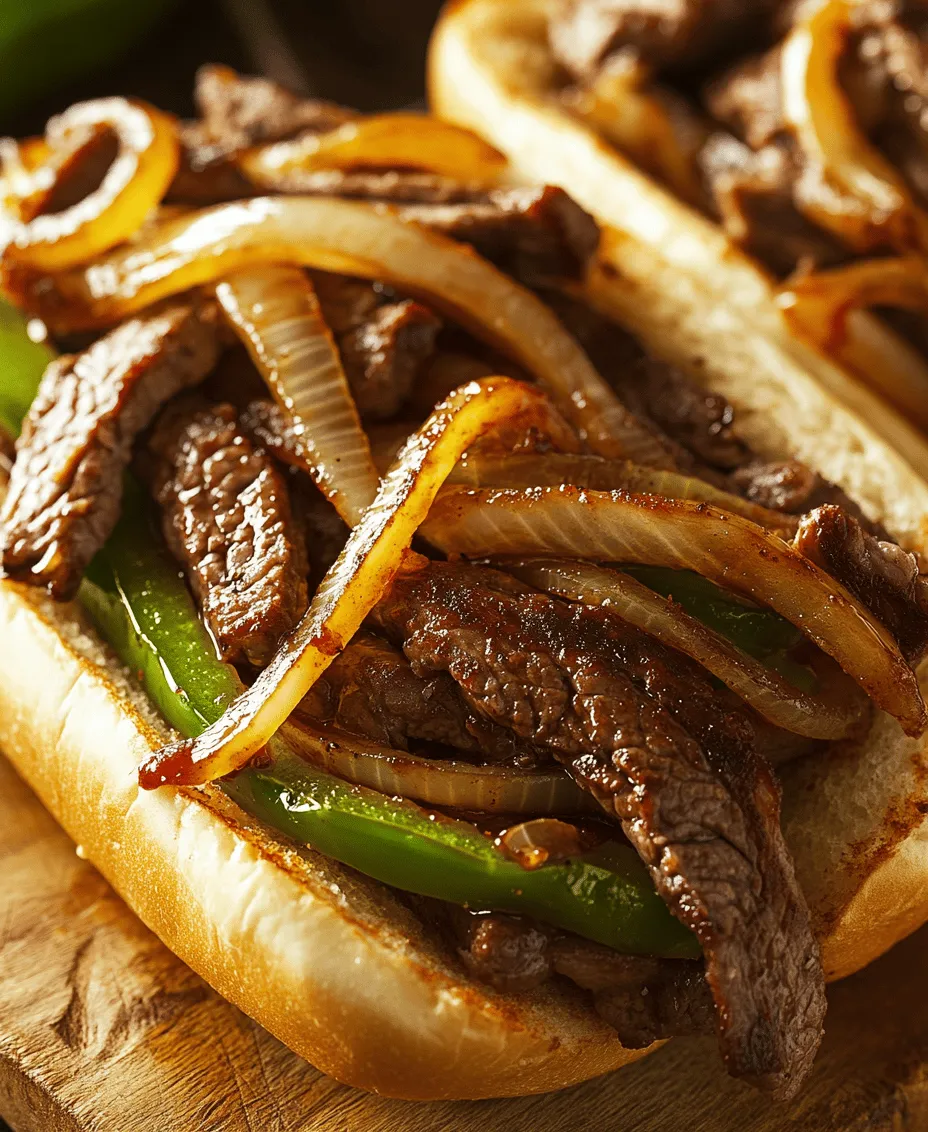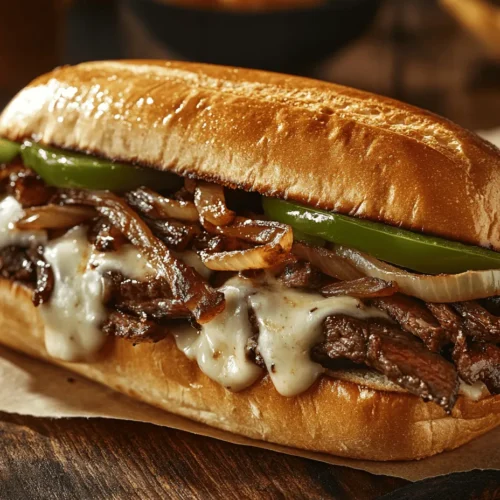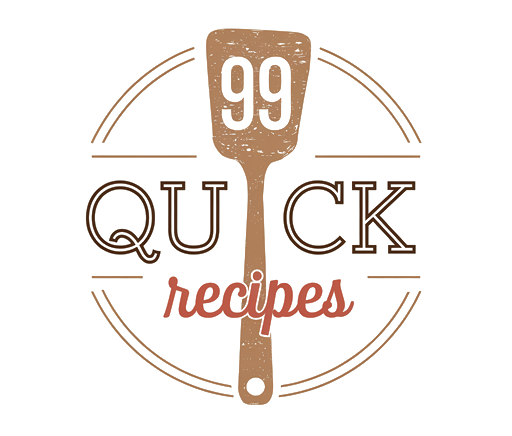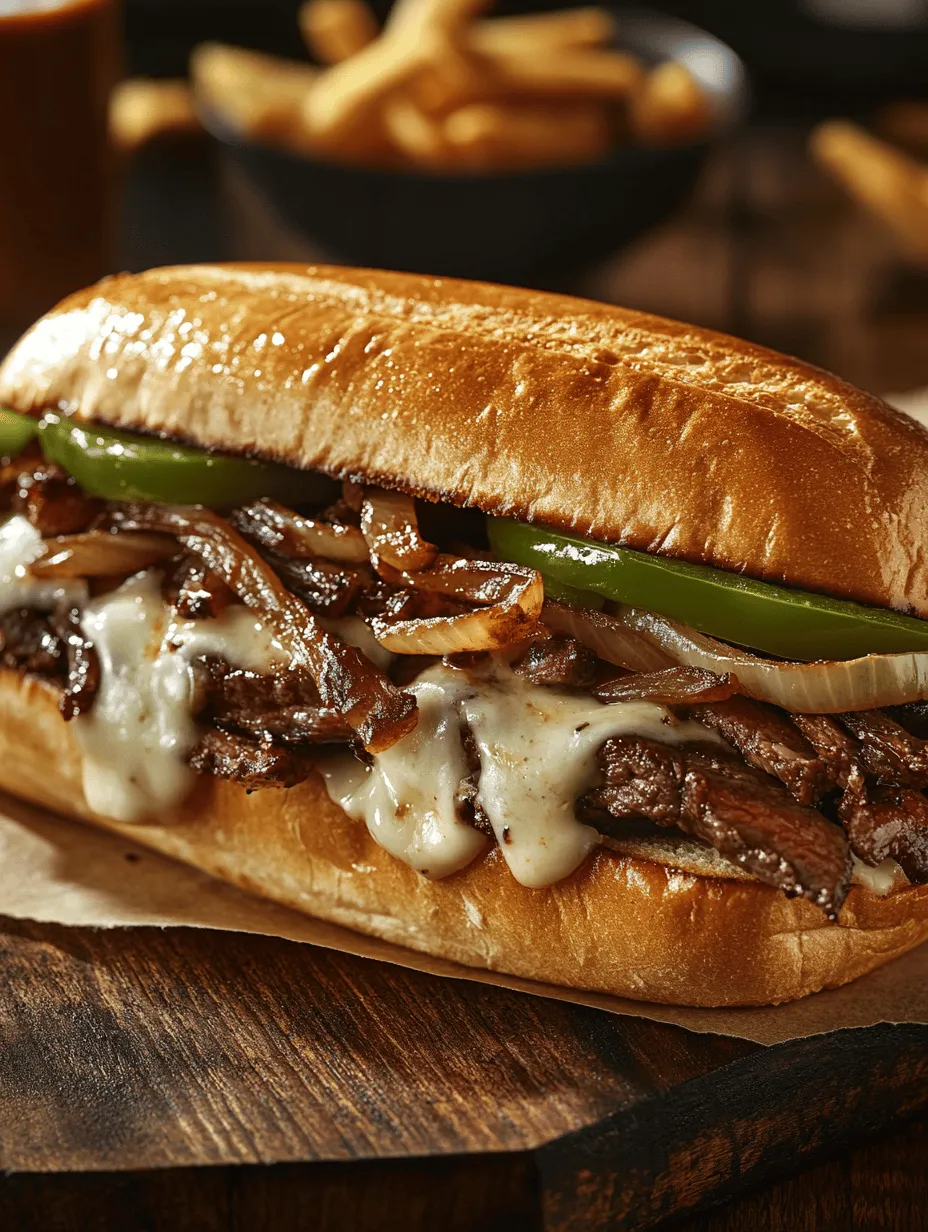Introduction
When it comes to iconic American cuisine, few dishes capture the heart and appetite quite like the Philly cheesesteak. Originating from the bustling streets of Philadelphia, this mouth-watering sandwich has become a beloved staple not only in its hometown but across the entire country. The allure of a cheesesteak lies in its perfect harmony of flavors and textures: the tender, juicy beef melded with sautéed onions and peppers, all enveloped in a soft, chewy hoagie roll and topped with gooey melted cheese. While countless restaurants and food trucks offer their interpretations, nothing quite compares to the satisfaction of creating this dish in your own kitchen.
Making a homemade Philly cheesesteak allows for greater control over the ingredients and the cooking process, resulting in a sandwich that can be tailored to your personal taste. By using high-quality ingredients and following a few simple steps, you can recreate this classic dish with amazing flavor and texture that rivals any takeout version. The secret lies in understanding the nuances of the ingredients and the cooking techniques that elevate each component of the sandwich.
Understanding the Origins of the Philly Cheesesteak
To truly appreciate the Philly cheesesteak, it helps to delve into its rich history. The cheesesteak was born in the 1930s when Pat Olivieri, a hot dog vendor in Philadelphia, decided to grill up some beef on his cart. The enticing aroma attracted the attention of passing cab drivers, prompting Olivieri to serve his creation on a roll. The dish quickly gained popularity, and in 1930, he opened Pat’s King of Steaks, which remains a popular cheesesteak destination today.
Over the years, the cheesesteak has evolved, resulting in numerous variations. While the traditional version features thinly sliced ribeye steak, sautéed onions, and melted cheese, regional adaptations have emerged. For instance, in some areas, you may find the addition of sautéed bell peppers or mushrooms, while others might favor a spicy twist with jalapeños or hot peppers. These variations reflect local tastes and preferences, contributing to the cheesesteak’s widespread appeal.
The cultural impact of the Philly cheesesteak cannot be overstated. It has become synonymous with Philadelphia itself, often regarded as a culinary ambassador for the city. Beyond its local status, cheesesteaks have gained traction across the United States, with food lovers seeking to replicate the experience at home or enjoy a taste of Philadelphia wherever they are. The cheesesteak embodies the American spirit of innovation, transforming humble ingredients into a beloved dish that transcends borders.
Key Ingredients for the Perfect Philly Cheesesteak
Creating the best Philly cheesesteak starts with understanding the essential ingredients that contribute to its signature flavor and texture. Here’s a closer look at what you’ll need to assemble this iconic sandwich.
Ribeye Steak: The Preferred Choice
The cornerstone of any great cheesesteak is the meat, and ribeye steak is the undisputed champion. Known for its marbling and tenderness, ribeye offers a rich, beefy flavor that is hard to beat. The fat content in ribeye ensures that it remains juicy throughout the cooking process, making every bite satisfying. When selecting ribeye, look for cuts that are fresh and well-marbled for optimal flavor.
Onions and Bell Peppers: Flavor and Texture
Onions and bell peppers play a crucial role in the overall flavor profile of the cheesesteak. Caramelizing these vegetables enhances their natural sweetness, creating a delightful contrast to the savory beef. Onions add depth and richness, while bell peppers introduce a fresh, slightly crisp texture. Together, they create a symphony of flavors that elevate the sandwich from good to extraordinary.
Provolone Cheese vs. Cheese Whiz: Making the Right Choice
One of the most hotly debated topics among cheesesteak aficionados is the choice of cheese. Traditionalists often opt for provolone, a semi-soft Italian cheese that melts beautifully and adds a creamy, savory note to the sandwich. Others swear by Cheese Whiz, a processed cheese product that offers a distinct flavor and gooey texture. Ultimately, the choice comes down to personal preference; both options can create a delicious cheesesteak when used correctly.
Hoagie Rolls: The Importance of Bread
The bread is just as vital as the filling when it comes to cheesesteaks. A good hoagie roll should be soft yet sturdy, capable of holding up against the juicy filling without falling apart. Look for fresh, quality rolls from a local bakery or grocery store. The ideal roll should have a slightly crispy exterior and a fluffy interior, providing the perfect vessel for all the flavorful ingredients.
Optional Ingredients to Customize Your Cheesesteak
While the classic cheesesteak is undeniably delicious, don’t hesitate to get creative with optional ingredients that can enhance flavor and spice. Sliced mushrooms can add an earthy depth, while jalapeños can introduce a kick of heat. Other variations might include toppings like sautéed spinach, garlic aioli, or hot sauce, allowing you to tailor your cheesesteak to your unique taste preferences.
Step-by-Step Guide to Making the BEST Philly Cheesesteak
Now that you understand the origins and key ingredients of the Philly cheesesteak, let’s delve into the step-by-step process of making this iconic sandwich.
Preparing the Steak
The first step in crafting the perfect cheesesteak is preparing the steak itself. For optimal results, consider freezing the ribeye for about 30 minutes before slicing. This technique firms up the meat, making it easier to cut into thin, uniform slices. Aim for slices that are approximately 1/8 inch thick—this ensures they cook quickly and evenly, yielding a tender bite.
Cooking the Vegetables
While the steak is a star player, don’t underestimate the importance of the vegetables. Begin by heating a skillet or griddle over medium heat and adding a drizzle of oil. Once hot, add thinly sliced onions and bell peppers to the pan. The goal is to caramelize the onions while cooking the bell peppers until they’re tender.
To achieve this, stir the vegetables occasionally and allow them to cook for about 10-15 minutes, or until they are golden brown and fragrant. Season with salt and pepper to taste, which will help balance the sweetness of the onions and the freshness of the bell peppers.
Balancing Flavors with Seasoning
As the vegetables finish cooking, it’s time to add the sliced ribeye to the skillet. Increase the heat to medium-high and add the steak directly to the pan, spreading it evenly over the cooked vegetables. Cooking the steak alongside the vegetables allows the flavors to meld beautifully.
Season the steak with additional salt and pepper, and consider adding a dash of garlic powder or a splash of Worcestershire sauce for an extra layer of flavor. Cook the steak for about 3-5 minutes, stirring occasionally, until it is browned and cooked through.
Now that you have the steak and vegetables ready, you are well on your way to assembling a Philly cheesesteak that will delight your taste buds.
Stay tuned for the next part, where we will discuss how to assemble and serve your homemade cheesesteak, as well as tips for achieving the ultimate cheesesteak experience.

Cooking the Steak
To achieve a truly authentic Philly cheesesteak, the cooking of the steak is paramount. Start by heating a large skillet or griddle over medium-high heat. Once the pan is hot, add a tablespoon of oil, ensuring that the surface is evenly coated. This initial step is crucial as it helps to create a nice sear on the steak, enhancing its flavor.
Next, add the sliced steak to the pan. It’s important to avoid overcrowding the pan; if necessary, cook the steak in batches. Overcrowding can trap moisture and result in steaming instead of searing. Allow the steak to cook undisturbed for a few minutes until the bottom side is browned. Then, use a spatula to flip the pieces, ensuring they cook evenly on both sides.
Key Tips for Achieving the Ideal Doneness
For the best cheesesteak, you want your steak to be tender and juicy, ideally cooked to medium-rare or medium. This allows the meat to retain its flavor and moisture. A meat thermometer can be a handy tool, with medium-rare reaching an internal temperature of 130-135°F and medium hitting 140-145°F.
Stirring Techniques for Even Cooking
When cooking the steak, stir gently but consistently to ensure even cooking. Use a spatula to break up any larger pieces, allowing for a uniform texture throughout. Stirring also helps to incorporate the meat’s natural juices, enhancing the overall flavor of the dish.
Combining Ingredients for Maximum Flavor
Once the steak reaches your desired doneness, it’s time to bring in the vegetables. Adding sautéed onions and bell peppers will enhance the flavor profile of your cheesesteak. If you’ve prepped these ingredients earlier, now is the time to reintroduce them to the pan.
Importance of Reintroducing Vegetables to the Meat
The key to a delicious Philly cheesesteak is the balance of meat and vegetables. By combining the cooked steak with the onions and peppers, you allow the flavors to meld together. Stir gently to mix the ingredients thoroughly, ensuring that each bite is a harmonious blend of meat and veggies.
Ensuring Everything is Heated Through
After combining, continue to cook for an additional minute or two, just enough to heat through the vegetables and marry the flavors of the steak, onions, and peppers. This final step is crucial as it ensures that every component of the sandwich is warm, ready to complement the melted cheese that will follow.
Melting the Cheese
The iconic element of the Philly cheesesteak is, of course, the cheese. Whether you prefer provolone, Cheez Whiz, or American cheese, the melting technique you use can make or break the sandwich.
Techniques for Achieving the Perfect Melt
To melt the cheese effectively, add slices of your chosen cheese directly on top of the meat and vegetable mixture. Cover the pan with a lid to trap the heat and steam, which facilitates the melting process. This method ensures that the cheese melts evenly without burning the meat underneath.
Using a Lid to Trap Heat Effectively
Using a lid is key in achieving that ooey-gooey cheese texture that everyone loves. Allow the cheese to melt for about 2-3 minutes, checking occasionally to ensure it’s melting but not overcooking the steak. You’ll know it’s ready when you see the cheese bubbling and stretching.
Assembling the Sandwiches
Now that your steak and cheese mixture is ready, it’s time to assemble the sandwiches. Start by warming the hoagie rolls. This is an often-overlooked step but is essential for achieving the best texture.
Tips for Warming Hoagie Rolls for the Best Texture
You can warm the rolls in a few different ways. One option is to place them in the oven at 350°F for about 5-10 minutes until they’re warm and slightly crispy. Alternatively, you can slice them and place them on a skillet for a minute or two, which adds a nice toasty flavor.
Presentation Ideas for Serving
When it comes to serving your Philly cheesesteak, presentation matters. Cut the sandwiches in half to reveal the melty cheese and colorful vegetables. Serve them on a wooden board or a simple plate, with a small bowl of dipping sauce, like spicy ketchup or a homemade garlic aioli, on the side for an extra touch.
Adding Final Touches
To elevate your cheesesteak further, consider adding some final touches before serving. A drizzle of hot sauce or a sprinkle of freshly cracked black pepper can enhance the flavor profile significantly.
Suggestions for Enhancing Flavor with Sauces and Toppings
Some popular additions include sautéed mushrooms, jalapeños, or even a light spread of horseradish sauce for a kick. Fresh herbs like parsley can also add a burst of flavor and visual appeal.
Serving Suggestions and Pairings
A Philly cheesesteak is delicious on its own, but it’s even better with the right accompaniments.
Recommended Sides to Serve with Philly Cheesesteaks
Classic options include crispy French fries or potato chips that provide a satisfying crunch. Alternatively, a light side salad with a tangy vinaigrette can balance the richness of the cheesesteak.
Beverage Pairings That Complement the Flavors of the Sandwich
When it comes to beverages, consider serving your cheesesteak with a cold beer, which complements the savory flavors of the sandwich beautifully. If you prefer non-alcoholic options, a refreshing iced tea or lemonade can also work well to cut through the richness.
Nutritional Information of the Philly Cheesesteak
Understanding the nutritional content of your meal is essential, especially if you’re making it a regular part of your diet.
Breakdown of Calories and Nutritional Content per Serving
A standard Philly cheesesteak typically contains around 600-800 calories, depending on the size and the type of cheese used. It also provides a significant amount of protein, largely from the steak, as well as carbs from the hoagie roll.
Discussion on the Nutritional Benefits and Considerations of the Ingredients
While a cheesesteak is undoubtedly indulgent, it does offer some nutritional benefits. The steak is a good source of protein, and if you load up your sandwich with vegetables, you can increase fiber and nutrient content. However, it’s important to enjoy this dish in moderation, considering its higher calorie count.
Balancing Indulgence with Health-Conscious Choices
To make your cheesesteak a bit healthier, consider opting for leaner cuts of meat, using whole grain rolls, or incorporating more vegetables. You can even experiment with lower-fat cheese options to maintain flavor while reducing calories.
Conclusion
In summary, creating the perfect Philly cheesesteak involves careful attention to the quality of your ingredients and the techniques used in cooking. From the way you prepare the steak to how you melt the cheese and assemble the sandwich, each step plays a critical role in achieving that iconic taste.
We encourage you to try making this beloved classic at home. Not only will you enjoy the delightful flavors of a homemade Philly cheesesteak, but you’ll also have the satisfaction of crafting a dish that brings friends and family together.
Share your experiences or variations of this recipe, and embrace the joy of cooking. Whether you’re indulging in a traditional cheesesteak or putting your twist on it, this sandwich is sure to become a favorite in your household. Happy cooking!


